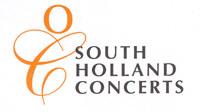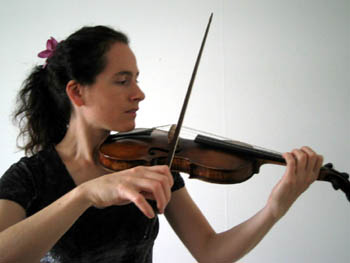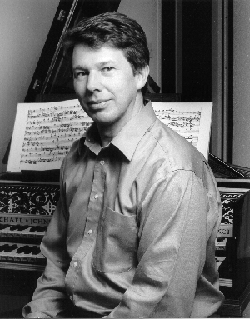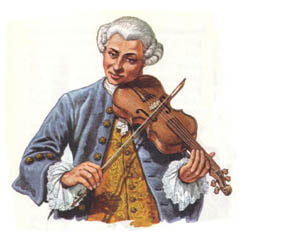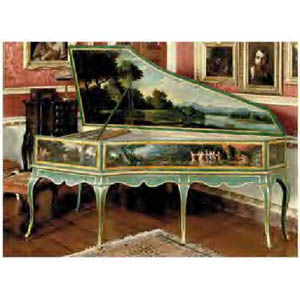THE PROGRAMME
Sonata in F major, op.5 no.10 Archangelo Corelli (1653-1713)
Sonata in A major RV 758 Antonio Vivaldi (1678-1741)
Sonata in G major K2 (Presto); Sonata In G Minor K12 (Presto) - for
harpsichord Dominico Scarlatti (1685-1757)
Sonata no. 4 in C minor BWV 1017 Johann Sebastian Bach (1685-1750)
Medley of Dances and Theatre tunes Henry Purcell (1659-1695)
La Marche des Scythes Pancrace Royer (1705-1755) from Pieces de Clavecin
1746 - for harpsichord
Sonata in D George F. Handel (1685-1759)
Sonata in F major, op.5 no.10 Archangelo Corelli (1653-1713)
Preludio; Allemande; Sarabanda; Gavotte; Giga
In Italy, by the middle of the seventeenth century, the town of Bologna
had become an extremely important centre for instrumental music-making.
This was centred largely on the basilica of San Petronio where the famous
violinist Torelli (1658-1709) was a particularly prominent figure. Though
he spent the largest part of his life in Rome, Archangelo Corelli also
studied in Bologna around this time, though records show that some felt
him to have been a curious character. While utterly respected for his
musicianship, discipline and beautiful evenness of bowing, it is also
recorded that: "While he plays upon the violin, his eyes will sometimes
turn as red as fire. His countenance will be distorted, and his eyeballs
roll as in agony!"
Having said that, Corelli's musical reputation spread
quickly, and through his subsequent teaching and performing, there developed
a major school of violin playing which had a significant influence on
player/composers throughout Europe. The early music of Antonio Vivaldi,
for example, owed a strong debt to Corelli, and few musicians from then
on escaped the dominant influence of Corelli's style.
Sonata in A major RV 758 Antonio Vivaldi (1678-1741)
Preludio; Corrente; Andante; Presto
Alongside such composers such as Marcello and Albinoni, the most famous
of the Venetian violinist/composers by far was Antonio Vivaldi. Son
of a leading violinist at St Mark's chapel, he was educated both for
a musical career and for the priesthood. (The combination of sacred
office and secular profession was not uncommon in those days.) Like
his contemporaries, Vivaldi composed each work for a specific occasion
and for a particular company of performers. While it would be a mistake
to ignore his achievements in opera, cantata and oratorio, he is chiefly
remembered today for his instrumental music.
For the greater part of his life, Vivaldi was employed
at a large conservatory (or convent school) at the town of Pietá, and
for the young and enthusiastic orchestra there he wrote many of his
orchestral pieces and concertos. While the ultimate influence he had
upon the progress of instrumental music was just as significant as Corelli's
had been a generation earlier, many of Vivaldi's compositions (his later
orchestral work and the numerous Sonatas for single instrument and harpsichord)
allow us to enjoy music by a composer clearly revelling in that exciting
transition of style between the late Baroque and new early-Classical
period.
Sonata in G major K2 (Presto); Sonata In G Minor K12
(Presto) - for harpsichord Dominico Scarlatti (1685-1757)
Dominico Scarlatti was the son of Alessandro Scarlatti who was extremely
important in his time - chiefly as a composer who established Naples
as a major centre for Italian opera. As an eminent harpsichordist who
held posts in many courts throughout Europe (including a period working
at the Italian Theatre in London), Dominico is almost entirely remembered
for his many hundreds of single-movement sonatas for that instrument.
In Scarlatti's music, the term 'Sonata' in not used in
the 'classical' sense of that word (as in Haydn, Mozart. etc.), but
it simply signified that the piece was an instrumental one. However,
that does not mean that his 'Sonatas' are without form. Later Classical-period
composers moulded their sonatas in a particularly formal and structured
way. Scarlatti's pieces, by contrast, generally display delightfully
quick-witted musical arguments into which the composer interweaves and
juxtaposes a number of sharply-contrasted themes and ideas. The result
is absorbing music that is full of charm and energy.
Sonata no. 4 in C minor BWV 1017 Johann Sebastian Bach
(1685-1750)
Largo; Allegro; Adagio; Allegro
This composer, of course, needs no introduction. To many music-lovers,
the six sonatas for violin and harpsichord (plus those also for cello
and for flute) are already familiar pieces of great beauty. One important
characteristic of most of these sonatas is the way in which almost the
entire interest is focused upon the melody. This, for example, is evident
in the very first Largo movement (marked 'Siciliano') in this C minor
Sonata - where Bach's broad, singing violin melody is accompanied throughout
by semi-quaver passage-work by the harpsichord. Another important feature
of Bach's instrumental sonatas (including the unaccompanied Sonatas
and Partitas), is the exquisite beauty of all his slow movements. Not
only does this sonata begin with the slow Siciliana, but it boasts a
particularly lovely Adagio too - accompanied, this time, by simple triplets
in the harpsichord part. The two additional Allegro movements are full
of spirit and dance-like vitality. For those who may be unfamiliar with
Bach's string Sonatas, this work is a typical (and particularly fine)
introduction.
Medley of Dances and Theatre tunes Henry Purcell (1659-1695)
Air; Round O; A New Ground; Hornpipe; Canary; Ground in Gamut
Bach was just ten years old when Purcell died, but unlike Bach, Purcell
was born into a family of professional musicians. His father and his
uncle were both musicians in the court of Charles 1st, and Henry was
one of twelve children of the Chapel Royal. He spent nearly all his
adult life in or around the city of Westminster with musical appointments
at Whithall Palace, the Chapel Royal at St James's, and at Westminster
Abbey.
Purcell wrote extensively for the church and for the theatre
(his operas The Fairy Queen and Dido and Aeneas are still performed),
and he composed numerous light dance tunes and miniatures for various
instrumental forces. He is an important figure, not only because of
the charm (and yet emotional poignancy) of much of his music, but also
because he stands at a pivotal point in history - between the Renaissance
composers and the Baroque era of the likes of J. S. Bach.
La Marche des Scythes Pancrace Royer (1705-1755) from
Pieces de Clavecin 1746 - for harpsichord
Today, regrettably, the music of Joseph-Nicolas-Pancrace Royer is not
well-known to audiences. However during his life-time he gained considerable
reputation as a Parisian harpsichordist, and it is possible that he
studied music with a cousin of François Couperin. He was notable for
organising concerts in which he championed music by contemporary composers
such as Stamitz and Pergolesi and re-introduced audiences to operas
of older Italian composers such as Carissimi.
Royer's own music is largely for the stage. But in those
compositions and in his Pieces de Clavecin we can hear instances of
his noted predilection for fiery dotted-rhythms and ornamental scale
passages. Royer was a highly professional composer with an original
style who clearly deserves better recognition.
Sonata in D George F. Handel (1685-1759)
Affetuoso; Allegro; Larghetto; Allegro
Handel is another composer of the Baroque period whose sonatas for strings
are numerous. His Fifteen Sonatas Op.1 include seven accompanied sonatas
for flute, six for violin and two for oboe. Shortly after settling in
England in his mid-20s, Handel came under the patronage of the Duke
of Chandos at his glorious country house near Edgware. In this period
before Handel's operatic career got under way, his duty was to compose
an endless supply of instrumental music largely for social occasions.
This soirée music (into which the violin sonatas fit neatly)
was required to give discreet pleasure without in any way distracting
the social gathering! (A somewhat similar requirement fell later on
Mozart when he was called on to compose numerous instrumental Serenades
and Divertimenti - which have sweetly been termed 'music to eat by'!)
But music which is not profound (and much of Handel's familiar music
is,) should not be seen as insignificant. His sonatas are full of invention,
imaginative and transparent part-writing, and melodies which are memorable.
In all, this is music written to perfection for the instruments in hand.
Enjoy!
